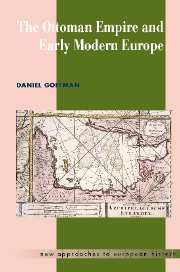Book contents
- Frontmatter
- Contents
- List of illustrations
- List of maps
- Preface
- Acknowledgements
- Note on usage
- Chronological table of events
- The Ottoman House through 1687
- 1 Introduction: Ottomancentrism and the West
- Part 1 State and society in the Ottoman world
- Part 2 The Ottoman Empire in the Mediterranean and European worlds
- Kubad in Venice
- 5 The Ottoman–Venetian association
- Kubad between worlds
- 6 Commerce and diasporas
- Kubad ransomed
- 7 A changing station in Europe
- 8 Conclusion: The Greater Western World
- Glossary
- Suggestions for further reading
- Index
- NEW APPROACHES TO EUROPEAN HISTORY
7 - A changing station in Europe
from Part 2 - The Ottoman Empire in the Mediterranean and European worlds
Published online by Cambridge University Press: 05 June 2012
- Frontmatter
- Contents
- List of illustrations
- List of maps
- Preface
- Acknowledgements
- Note on usage
- Chronological table of events
- The Ottoman House through 1687
- 1 Introduction: Ottomancentrism and the West
- Part 1 State and society in the Ottoman world
- Part 2 The Ottoman Empire in the Mediterranean and European worlds
- Kubad in Venice
- 5 The Ottoman–Venetian association
- Kubad between worlds
- 6 Commerce and diasporas
- Kubad ransomed
- 7 A changing station in Europe
- 8 Conclusion: The Greater Western World
- Glossary
- Suggestions for further reading
- Index
- NEW APPROACHES TO EUROPEAN HISTORY
Summary
For your Greek subjects of the island of Candia, and the other islands of the Levant, there is no doubt but there is some greater regard to be had of them, first, because that the Greek faith is never to be trusted; and perhaps they would not much stick at submitting to the Turk, having the example of all the rest of their nation before their eyes: these therefore must be watch'd with more attention, lest, like wild beasts, as they are, they should find an occasion to use their teeth and claws. The surest way is to keep good garrisons to awe them, and not use them to arms or musters, in hopes of being assisted by them in an extremity: for they will always shew ill inclinations proportionably to the strength they shall be masters of.
Most historians have portrayed a post-Süleymanic Ottoman world in decline. Their evidence for such a downturn is principally military. It is often argued that the Ottoman navy never fully recovered either its power or its prestige after the débâcle of Lepanto (1571), and that the Ottoman army never rediscovered its fortitude and fierceness after the long wars against the Habsburg and Safavid empires that brought the sixteenth century to a close and engendered the stalemating Peace of Zsitva-törok (1606). Consequently, the argument goes, concession, retreat, and retrenchment characterized Ottoman history during the seventeenth through the nineteenth centuries. The reality, of course, was much more complicated than this representation suggests.
- Type
- Chapter
- Information
- The Ottoman Empire and Early Modern Europe , pp. 192 - 226Publisher: Cambridge University PressPrint publication year: 2002

